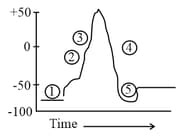Excitation, Conduction and Transmission of Nerve Impulses
Excitation, Conduction and Transmission of Nerve Impulses: Overview
This topic covers concepts, such as, Nerve Impulse,Resting Potential,Conduction of Nerve Impulse etc.
Important Questions on Excitation, Conduction and Transmission of Nerve Impulses
What is synapse?
Two neurons, and , synapse onto a third neuron, . If neurotransmitter from A opens ligand-gated channels permeable to and and neurotransmitter from opens ligand-gated channels, which of the following statements is true?
Which event of the nerve impulse is indicated by the number (5) in the diagram?

What happens to the neuron when it in the depolarised state.
The new potential developed on Postsynaptic membrane is
Axoplasm have which of the following in polarized state?
The resting axonal membrane is
Resting membrane potential of a neuron is approximately
Which event causes depolarisation of a neuron?
Read the statements and find the correct option:
I. Resting the axonal membrane is almost impermeable to Na-ions and K-ions.
II. A polarised membrane, upon receiving the stimulus, becomes depolarised, and rapid efflux of NA-ion takes place.
III. The duration of stimulus-induced change of permeability for NA-ion is very short-lived.
IV. Repolarisation occurs only when there is an efflux of K-ions.
What occurs in the synaptic cleft?
The correct pathway of conduction of impulses through a neuron is :
Each neuron has a cell body, axon, and dendrites. The dendrites are the protoplasmic extensions of the nerve cell. The axodendritic type of chemical synapse is formed by the association between the axon terminal of the pre-synaptic neuron and the dendrites of a post-synaptic neuron. The action potential causes the fusion of the synaptic vesicle to release the neurotransmitters for neurotransmission. Select the correct option from the following.
Synaptic cleft does not allow the neurotransmitters to diffuse through it.
During generation of an action potential, depolarisation is due to:
Resting membrane potential of a neuron is approximately:
Once a synaptic junction between neurons has allowed transmission of a nerve impulse, it is made ready to transmit next impulse by the action of:
Saltatory conduction occurs in
Which is a characteristic of a graded potential
Potential difference across resting membrane is negatively charged. This is due to differential distribution of the following ions
